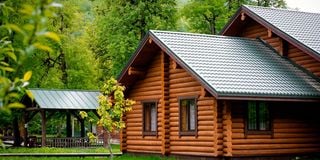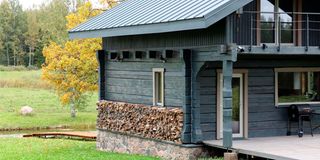
A wooden house.
In the late 19th century, asbestos became popular in the construction industry. Though the material had been used before this in multiple industries, it was seen as a "magic material" for the construction sector.
With its fire, thermal and electricity resistance as well as acoustic qualities, asbestos could be used in a myriad of ways.
Its application peaked between the 1920s and 70s, before experts realised that it was carcinogenic. Prolonged exposure to it could cause a number of diseases.
In 1972, Denmark was the first country to ban asbestos use in thermal insulation, acoustics and waterproofing, according to data from the International Ban Asbestos Secretariat.
What followed was a series of similar actions around the globe. And just like that, the "magic material" exited the industry.
In the wake of climate change and the global economic crisis, the construction industry is exploring new and alternative materials more than ever before. Statistically, the global alternative materials market is expected to attract a Compound Annual Growth Rate (CAGR) of 6 percent between 2022 and 2030.
Here in Kenya, alternative materials are gaining popularity by the day. From walling to roofing, flooring, lighting and interiors, people are looking for sustainable, cost-effective and energy efficient materials.
Perhaps, you want to take this direction too, with your project. What factors should you consider before settling for specific materials, and where are we going wrong in our overall implementation?
Architect Vicky Karuga of Tarakibu Architects, shares her observations and expert advice. Over the 22 years Vicky has been an architect, she says so much has changed when it comes to materials in construction.
"Architects and Designers have a more diverse palette of materials to choose from now. We have innovative materials such as the energy efficient smart glass and smarter glass films. Then there are solar and alternative energy elements as well as smart building technologies that allow function to follow form," Karuga says.

Safety is also an important topic to explore when considering alternative materials.
"There is also a growing emphasis on sustainability and environmental responsibility which inspires increased use of eco-friendly materials such as recycled steel, reclaimed wood, bamboo, slate stone and other renewable resources," she adds.
When she started out, Vicky recalls, the kitchens, for instance, had a limited supply of materials.
"We had one or two serious providers for all our projects. Now we almost get lost in the numerous options, including home grown experts delivering from locally available sources with good workmanship".
Factors influencing change
It seems sustainability and conversations around climate change have a major contribution to adoption of alternative materials. The construction industry is one of the leading contributors of carbon emissions.
Concrete, the most commonly used material, has been dominant for a long time due to its efficiency, availability and cost effectiveness. But its production and application is estimated to cause 8 percent of the global CO2 emissions.
To counter the impact, Karuga explains, experts are now making use of light emitting concrete, a “greener” version that lights up highways and pathways, reducing the need for additional lighting. This significantly reduces energy consumption on roads and highways.
Other materials that have attracted attention, especially in Kenya, include engineered wood and zinc-aluminium tiles which are replacing traditional clay tiles. Bamboo, which has multiple uses in flooring, paneling, roofing, furniture and walling among other uses has also seen significant growth.
Materials that would ordinarily replace walling stones have however struggled to earn their place in construction.
For instance, says Karuga, "Precast panels have struggled to gain the popularity they should have by now, but this has more to do with the pricing point and our mindset, rather than associated benefits,”
She further explains that though precast panels and traditional masonry walling present challenges, masonry stones have always been readily available and quite cost effective when building.
“When the precast panels first came into the country, it was a hard sell because the cost difference wasn’t that much for a single unit unless you were doing mass housing. And this difference did not make up for certain things we still value in masonry walling such as the flexibility, the aesthetics and the readily available skill for a material that has been time tested.”
The architect explains that the traditional wall still has many preferred benefits, including superior sound insulation and fire resistance, while the set up costs for any manufacturing plant providing precast panels have also been significant in driving up the cost of using this technology.
There is, however, one more factor that might propel precast panels to stardom. As she explains, time is a key factor in construction. The amount of time it takes to complete a project affects labour costs as well as mortgage repayment timelines and subsequent interest rates.
"Precast panels might provide this much needed shorter building time. It takes less time to install them compared to layering one stone at a time, and it is easier to ensure quality control. Working with panels also means a less messy operation on site and possibly less fundis.
Mistakes Kenyans are making
Popular materials aside, what are some of the mistakes Kenyans are making when working with alternative materials?
Vicky says that often, mistakes stem from lack of information, insufficient research and poor evaluation when it comes to specific alternative materials.
"Many issues arise at the initial stage because the anticipated benefits or outcomes of a specific alternative material may not align with reality. For instance, one might opt for a particular material without fully understanding the maintenance costs associated with it," she says.
"You could also select a product because it is cost effective without realising that the specialised labour required to install it is not,” she explains further, pointing out that in a nutshell, sometimes we pay attention to positive aspects while overlooking potential consequences yet everything has advantages and disadvantages.

Green building adoption in Kenya has seen a significant rise, with over 100 buildings now either registered or certified.
Beyond the cost or aesthetic appeal, there is so much more to consider when working with alternative materials, and budget comes first.
"Budgets draw a significant line. In fact, one major problem is that project owners fail to share a true reflection of their budgets, but once this is established, the next step should entail exploring the lifetime value of a material. Sometimes people focus on some of the quick wins promised at that particular point in time," she says.
"But Buildings are not quick-win items. If a building is done right, it should last a lifetime, hence materials that might not be the current fad, but promise better maintenance and longevity are worth looking into," the architect says.
"A perfect example would be laminated flooring. You might get a good bargain but end up with warping floors and other issues. On the contrary, clay brick floors are not explored often, yet they are not too expensive. They also age well and are relatively aesthetically pleasing, but they might not fit in with the current trend."
Safety and standards
Safety is also an important topic to explore when considering alternative materials. With so many suppliers introducing new products into the market, there are risks to watch out for.
For starters, the architect explains, there is a risk of building with materials that do not meet the minimum standards in their category or even using defective materials.
Adequate after sales service also comes in handy during the maintenance period. It is advisable to work with suppliers who will outlive the construction period, avail replacements in case of repairs and also answer your questions as they arise in the future. She also insists on evaluating the availability of required skills for the installation and its cost.
“All materials should be registered and certified by the Kenya Bureau of Standards. There is also the Joint Building Contracts Committee, which lists an index of materials available, and their market price. If you are unsure, talk to an architect, engineer, quantity surveyor or building professional for further advice.”
When consulting the experts, there are questions you can ask to gain more insights on products. Vicky shares a few of the most crucial ones.
For starters, you may ask for various alternatives and evaluate the pros and cons of each. Find out whether the material has been utilised elsewhere, and whether it is possible to connect with end users for firsthand feedback.
If the material is imported, enquire about credible certifications from the supplier. You can always check online for this information.
“It's crucial to gather information on the supplier, as stability is key in an economy where some suppliers may be transient. Here today, gone tomorrow. Opt for a reputable supplier with a proven track record.”
In addition, engaging with the community where you plan to build is invaluable. Residents can provide valuable insights into the performance of different materials within the local climate’s context.
Their experiences can inform your decision-making process, and possibly help you avert a catastrophe.
Finally, as we delve deeper into alternative construction, there is a lot to learn from other countries when it comes to consumer protection and sustainability.
“I would cite sustainable practices from Scandinavia. Countries like Sweden and Norway have embraced sustainable construction practices which incorporate energy-efficient designs and renewable materials as well as green building certifications. Sustainability does not have to be complicated," says Karuga.
There are the old ways that we practiced in architecture, which you can still see in some buildings designed by our own local architects, such as using thermal masses for passive heating and cooling,” she says.
According to the architect, there are simple things you can incorporate into your design that really cut back on some of the maintenance costs and will not cost you much outside of the initial budget. Some of them need little innovation by way of materials.









